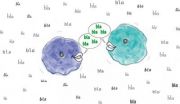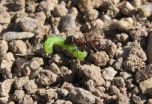(Press-News.org) It is much harder to keep up with a conversation in a crowded bar than in a quiet little café, but scientists wishing to eavesdrop on cells can now do so over the laboratory equivalent of a noisy room. A new method devised by scientists at the European Molecular Biology Laboratory (EMBL) in collaboration with the German Cancer Research Centre (DKFZ), both in Heidelberg, Germany, provides a new approach for studying the proteins cells release to communicate with each other, react to changes, or even to help them move. Published online today in Nature Biotechnology, the work also opens new avenues for drug and biomarker screening.
Cells in the lab have to be fed, and the 'serum' used to feed them contains proteins – many more proteins than the cells themselves secrete, or release into their environment. So for scientists attempting to eavesdrop on cells' conversations, it's like the cells are sitting in a room bustling with impenetrable chatter – until now. The new method developed by Jeroen Krijgsveld and colleagues allows scientists to distinguish proteins secreted by the cells from those in their food. And as they can measure exactly how much of each protein the cells have released, at just 2-hour intervals, scientists can see how secretion changes over time, for instance in response to changes in the cells' environment.
The EMBL scientists coax cells into using an artificial amino acid instead of the methionine they would normally employ as one of the building blocks for their proteins. The researchers can then fish out the proteins released by the cells from the surrounding serum, using a technique called click chemistry. This does away with the need to starve cells, which was so far the most reliable way of being sure you were not 'counting' proteins from the serum. And this is an important development, as the new approach showed that starving cells, even just for a few hours, affects secretion.
The double advantage of not having to starve cells and being able to follow changes over time enabled Krijgsveld and colleagues to follow, for the first time, how white blood cells called macrophages – which can't be grown without serum – react to a component of bacteria to kick off a rapid immune response.
"There's much more for the community to explore," Krijgsveld says: "our method could be used to watch how cells react to drug treatments; or to search for biomarkers, like the proteins cancer cells release that help them invade tissues; or to see how secretion changes if cells are grown in 3D instead of on a regular Petri dish. We've really seen a great deal of interest already."
As well as continuing to investigate the intricacies of secretion, Krijgsveld's lab now plan to use their new approach to study how cancer cells respond to drugs.
INFORMATION:
The work was done in collaboration with Stephan Herzig at DKFZ.
Cellular eavesdropping made easy
New method for identifying and measuring secreted proteins over time
2012-09-24
ELSE PRESS RELEASES FROM THIS DATE:
New IVF breakthrough
2012-09-24
Researchers at the University of Gothenburg have discovered that a chemical can trigger the maturation of small eggs to healthy, mature eggs, a process that could give more women the chance of successful IVF treatment in the future. The results have been published in the revered journal PloS ONE.
Women and girls treated for cancer with radiotherapy and chemotherapy are often unable to have children as their eggs die as a result of the treatment.
Although it is now possible to freeze eggs and even embryos, this is not an option for girls who have yet to reach puberty. ...
Immune system molecule affects our weight
2012-09-24
Researchers at the Sahlgrenska Academy, University of Gothenburg, Sweden, have identified a molecule in the immune system that could affect hunger and satiety. The researchers hope that new treatments for obesity will benefit from this finding.
Interleukin-6 is a chemical messenger in our immune system that plays an important role in fighting off infection. However, recent research has, surprisingly, shown that it can also trigger weight loss. Researchers at Sahlgrenska Academy, University of Gothenburg, have been investigating and managed to identify the specific types ...
New back pain gene identified in largest genetic study of its kind
2012-09-24
Researchers at King's College London have for the first time identified a gene linked to age-related degeneration of the intervertebral discs in the spine, a common cause of lower back pain.
Costing the UK an estimated £7billion a year due to sickness leave and treatment costs, the causes of back pain are not yet fully understood. Until now, the genetic cause of lower back pain associated with lumbar disc degeneration (LDD) was unknown, but the largest study to date, published this week in the journal Annals of Rheumatic Diseases, has revealed an association with the ...
Red king or red queen
2012-09-24
This press release is available in German.
The relationship between species determines how rapidly they evolve. Parasites and their hosts coevolve more rapidly, and partners in a mutualistic relationship can evolve more slowly. But this view is obviously too simplistic. The rate of evolution in a mutualistic relationship does not depend only on the type of interactions, but also on the number of individuals involved, according to a model developed by researchers of the Max Planck Institute for Evolutionary Biology in Plön, Germany. Therefore, while partners can benefit ...
Two-thirds of the world's new solar panels were installed in Europe in 2011
2012-09-24
Europe accounted for two thirds of the world-wide newly installed photovoltaic (PV) capacity in 2011, with 18.5 GW. Its overall PV capacity totalled 52 GW. The yearly electricity produced by PV could power a country with the electricity demand of Austria, which corresponds to 2% of the EU's electricity needs. These are some of the highlights of the 2012 Photovoltaics Status Report published today by the European Commission's Joint Research Centre.
The study summarises and evaluates the current activities regarding manufacturing, policies and market implementation world-wide. ...
Glacial youth therapy for the Scandinavian landscape
2012-09-24
The high elevation flat surfaces characteristic of the Norwegian landscape are in geologically terms young, according to a paper in Nature Geoscience.
In a paper recently published in Nature Geoscience, researchers from the University of Bergen (UiB) and ETH Zurich have demonstrated that ice sheets have extensively shaped the fjords of Norway for the last 2.8 million years.
– However, the massive sediment record deposited offshore Norway during this period tells us a more complex story, explains Postdoctoral Fellow Philippe Steer at UiB's Department of Earth Science ...
Fueling the fleet, Navy looks to the seas
2012-09-24
WASHINGTON--Refueling U.S. Navy vessels, at sea and underway, is a costly endeavor in terms of logistics, time, fiscal constraints and threats to national security and sailors at sea.
In Fiscal Year 2011, the U.S. Navy Military Sea Lift Command, the primary supplier of fuel and oil to the U.S. Navy fleet, delivered nearly 600 million gallons of fuel to Navy vessels underway, operating 15 fleet replenishment oilers around the globe.
From Seawater to CO2
Scientists at the U.S. Naval Research Laboratory are developing a process to extract carbon dioxide (CO2) and produce ...
Glass half full: Double-strength glass may be within reach
2012-09-24
Glass is strong enough for so much: windshields, buildings and many other things that need to handle high stress without breaking. But scientists wholook at the structure of glass strictly by the numbers believe some of the latest methods from the microelectronics and nanotechnology industry could produceglass that's about twice as strong as the best available today.
Rice University chemist Peter Wolynes is one of them. Wolynes and Rice graduate student Apiwat Wisitsorasak determined in a new study that a process called chemical vapor deposition, which is used industrially ...
Researchers demonstrate cheaper way to produce NFO thin films
2012-09-24
Researchers from North Carolina State University and the Georgia Institute of Technology have demonstrated a less-expensive way to create textured nickel ferrite (NFO) ceramic thin films, which can easily be scaled up to address manufacturing needs. NFO is a magnetic material that holds promise for microwave technologies and next-generation memory devices.
Specifically, this is the first time researchers have used a chemical deposition process to create NFO thin films that are "textured" – meaning they have an aligned crystalline structure. Arraying the crystalline structure ...
3-year, 676-child trial shows effectiveness of low-cost intervention to improve sun protection
2012-09-24
A blistering sunburn during childhood or adolescence more than doubles the adult risk of skin cancer. The accumulation of long-term sun exposure may be equally dangerous. A study from the Colorado School of Public Health and the University of Colorado Cancer Center recently published in the American Journal of Preventive Medicine shows one way to reduce this exposure: a double-blind randomized clinical trial of mailed sun protection packets led to higher frequency of sun protective behaviors including the use of long clothing, hats, shade, sunscreen, and midday sun avoidance.
"This ...
LAST 30 PRESS RELEASES:
Making lighter work of calculating fluid and heat flow
Normalizing blood sugar can halve heart attack risk
Lowering blood sugar cuts heart attack risk in people with prediabetes
Study links genetic variants to risk of blinding eye disease in premature infants
Non-opioid ‘pain sponge’ therapy halts cartilage degeneration and relieves chronic pain
AI can pick up cultural values by mimicking how kids learn
China’s ecological redlines offer fast track to 30 x 30 global conservation goal
Invisible indoor threats: emerging household contaminants and their growing risks to human health
Adding antibody treatment to chemo boosts outcomes for children with rare cancer
Germline pathogenic variants among women without a history of breast cancer
Tanning beds triple melanoma risk, potentially causing broad DNA damage
Unique bond identified as key to viral infection speed
Indoor tanning makes youthful skin much older on a genetic level
Mouse model sheds new light on the causes and potential solutions to human GI problems linked to muscular dystrophy
The Journal of Nuclear Medicine ahead-of-print tip sheet: December 12, 2025
Smarter tools for peering into the microscopic world
Applications open for funding to conduct research in the Kinsey Institute archives
Global measure underestimates the severity of food insecurity
Child survivors of critical illness are missing out on timely follow up care
Risk-based vs annual breast cancer screening / the WISDOM randomized clinical trial
University of Toronto launches Electric Vehicle Innovation Ontario to accelerate advanced EV technologies and build Canada’s innovation advantage
Early relapse predicts poor outcomes in aggressive blood cancer
American College of Lifestyle Medicine applauds two CMS models aligned with lifestyle medicine practice and reimbursement
Clinical trial finds cannabis use not a barrier to quitting nicotine vaping
Supplemental nutrition assistance program policies and food insecurity
Switching immune cells to “night mode” could limit damage after a heart attack, study suggests
URI-based Global RIghts Project report spotlights continued troubling trends in worldwide inhumane treatment
Neutrophils are less aggressive at night, explaining why nighttime heart attacks cause less damage than daytime events
Menopausal hormone therapy may not pose breast cancer risk for women with BRCA mutations
Mobile health tool may improve quality of life for adolescent and young adult breast cancer survivors
[Press-News.org] Cellular eavesdropping made easyNew method for identifying and measuring secreted proteins over time

